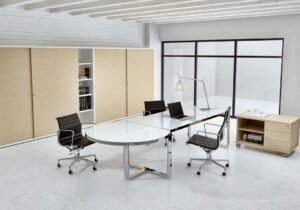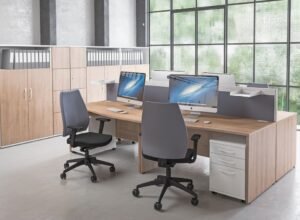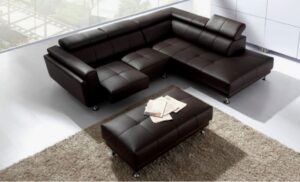An Office Desk is more than just a piece of furniture—it is the foundation of any productive workspace. Whether you’re setting up a home office or furnishing a large corporate environment, choosing the right office desk plays a vital role in how comfortable and efficient your working experience will be. The desk you choose should reflect not only your workflow and style but also provide ergonomic support for long hours of work. Office desks come in a variety of sizes, shapes, materials, and designs, making it important to understand your needs before making a decision. From minimalist workstations to executive corner desks, the range of options is vast. An ideal office desk helps you stay organized, supports your working posture, and enhances the aesthetics of your workspace. As more people embrace remote working and hybrid models, the demand for versatile, durable, and stylish desks has grown substantially.
Office Desk Types and Choosing the Right One
When choosing an office desk, you need to assess your workspace layout, the type of work you do, and the equipment you use. Some people need multiple monitors and extensive storage, while others may only need space for a laptop and notebook. Common types of office desks include writing desks, computer desks, executive desks, L-shaped desks, standing desks, and compact corner desks. Writing desks offer a sleek and minimal design, great for small spaces or occasional use. Computer desks usually include a dedicated area for your monitor, keyboard, and sometimes cable management systems. Executive desks, typically larger and more luxurious, often come with built-in drawers, cabinets, and ample surface area for files and documents. For those who like to switch between sitting and standing, adjustable-height desks can promote better posture and reduce back pain. Compact L-shaped desks are ideal for making the most of corner spaces and separating tasks between two surfaces. Selecting the right office desk helps create an environment where work can be done more efficiently and comfortably.
The Role of Ergonomics in Office Desk Design
One of the most crucial aspects of an office desk is its ergonomic design. A good office desk should allow you to maintain a healthy posture throughout the day. It should offer enough legroom, accommodate your chair height, and enable your arms to rest comfortably while typing. If you spend long hours at your desk, ergonomics become non-negotiable. Your desk should be paired with an ergonomic chair to ensure spinal alignment and reduce the risk of strain or injury. Desks with adjustable heights and angles are ideal for users who need more flexibility in their setup. Proper desk design also includes well-thought-out placement of drawers and shelves, ensuring you can access your essentials without excessive stretching or bending. With an ergonomic office desk, not only does your body stay healthier, but your mental focus and productivity also improve. Investing in ergonomically designed office furniture pays off in terms of both health benefits and work performance.
Office Desk Materials and Their Impact on Aesthetics
Office desks come in a range of materials, each offering unique advantages in terms of style, durability, and maintenance. Popular materials include wood, metal, glass, and laminate. Wooden office desks, especially those made from solid hardwood like oak or walnut, offer timeless elegance and warmth. They are sturdy and can last for decades with proper care. Metal desks, often used in more modern or industrial setups, are valued for their strength and minimalist appeal. Glass office desks add a touch of sophistication and are visually lighter, making smaller rooms feel more open. Laminate desks are budget-friendly and come in a wide range of finishes, from natural wood to contemporary colors. When selecting your desk, the material should align with your workspace’s interior theme and your personal preferences. Not only does the right material enhance the overall ambiance, but it also plays a role in the desk’s functionality and longevity. For example, if you frequently write or use heavy equipment, a solid wood or metal desk may be more appropriate.
Storage Solutions and Organization Features in Office Desks
Modern office desks often include a variety of storage options to help you stay organized and clutter-free. Depending on your needs, you might want a desk with drawers, file cabinets, open shelves, or even hidden compartments. An office desk with built-in storage keeps your essential items within reach and maintains a tidy workspace. File drawers are particularly useful for those dealing with physical documents, while keyboard trays can help keep the surface clear. Cable management solutions are increasingly important with the rise of electronic devices in the workplace. Desks with grommet holes or built-in cable trays help reduce the visual mess of cords and make cleaning easier. Keeping your office desk organized is not just about aesthetics—it directly impacts your productivity and mental clarity. A well-organized desk enables faster access to tools, reduces distractions, and creates a calming environment that fosters focus and creativity.
Office Desk Trends for Home and Commercial Spaces
The design of office desks has evolved with the shift in work culture. In recent years, multifunctional desks that blend aesthetics with usability have taken center stage. Minimalist and Scandinavian-style desks with clean lines are highly favored for home offices. These desks provide function without overpowering the decor of a living space. Meanwhile, in commercial settings, collaborative desks that support teamwork and shared spaces are growing in popularity. Sit-stand desks and those with modular components cater to workplaces emphasizing employee wellness. Another trend is the rise of tech-integrated desks, featuring built-in charging ports, wireless charging pads, or even smart storage that locks electronically. Sustainable office desk options made from reclaimed wood or recycled materials are also gaining attention, appealing to environmentally conscious buyers. With technology and work habits constantly evolving, today’s office desk must adapt to new requirements while maintaining comfort and style.
Customization and Office Desk Personalization
For those who want a workspace that truly fits their personality and work habits, custom office desks are an ideal solution. Customization allows users to determine the desk’s dimensions, shape, material, storage options, and color. Whether you need a compact desk for a small apartment or a grand executive desk for a corporate suite, tailor-made options ensure you get exactly what you need. Personalized features such as integrated lighting, branded elements, or tailored finishes can make your office desk feel more personal and inspiring. Even if you’re buying a ready-made desk, simple additions like desk organizers, monitor risers, and desk pads can enhance functionality and aesthetics. A customized or well-accessorized desk not only improves your work setup but also fosters a sense of ownership and motivation, especially in a remote working environment where creating your professional zone is vital.
Conclusion
Choosing the right office desk can significantly influence your productivity, posture, and workspace aesthetics. From ergonomic features and smart storage to materials and customization options, today’s office desks cater to a broad spectrum of needs. Whether for a home office or a bustling business center, the right desk is a fundamental investment that supports your daily tasks and long-term well-being. Selecting an office desk should always be a thoughtful decision that blends comfort, design, and practicality into a single functional piece of furniture that empowers your professional success.






